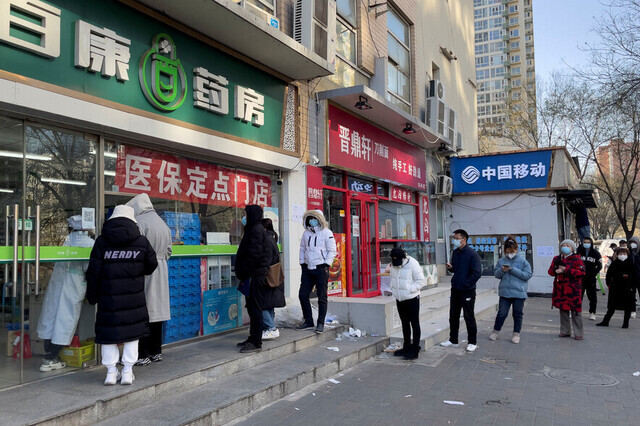hankyoreh
Links to other country sites 다른 나라 사이트 링크
Growing number of Korean firms leaving China to reshore

An increasing number of Korean companies that had factories in China are reshoring their operations. This trend is attributed to the worsening investment environment, as can be seen in slow economic growth.
In a report titled “2022 Returns of Overseas Enterprises to Korea,” the Ministry of Trade, Industry and Energy stated that 24 companies returned operations to Korea in 2022, 15 of which were companies that had factories in China.
Here, returning companies are companies that had support from the government by meeting the requirements of the Act on Assistance to Korean Off-Shore Enterprises in Repatriation. By country, there were four companies from Vietnam, followed by one each in the US, Japan, Taiwan, Mexico and Indonesia. The total number of returning companies was higher than that of 2020 (23 companies) and smaller than that of 2021 (26 companies.)
Since the reshoring support system was introduced in 2014, 126 companies in total have relocated to South Korea, and 77% of those companies (97 in number) were companies that had factories in China. The numbers are followed by 15 in Vietnam, four in the US, and two in Indonesia.
Most companies that returned operations to Korea chose to relocate to Gyeonggi Province, with 8 companies, followed by four to South Chungcheong, three to North Gyeongsang, and two to South Gyeongsang and North Jeolla respectively. Since 2014, 18 have relocated to Gyeonggi, South Chungcheong, and North Jeolla, 17 to North Gyeongsang, 16 to South Gyeongsang, and 10 to Busan.
In 2022, the planned investment of companies returning to Korea amounted to 1.1089 trillion won, an increase of 43.6% compared to 2021, exceeding 1 trillion won for the first time. Among the companies that returned to Korea, the proportion of mid-sized and large-sized companies was 37.5% (9 companies), which is the highest ever. This proportion was 26.1% in 2020, 34.6% in 2021, and 9.4% on average between 2014 and 2019.
The Ministry of Trade, Industry, and Energy stated that six companies that were identified as high-tech, supply chain core companies under related laws, such as Company S, a semiconductor and PCB company, and Company D, a semiconductor chemical product manufacturer, were among the firms that reshored to Korea. There were four cases of key high-tech and supply chain companies returning in 2020 and two in 2021.
The planned number of jobs for these companies was 1,794 people, 21.3% less than that in 2021. The Ministry of Trade, Industry and Energy explained that it was because most of the returning companies are involved in capital-intensive industries such as electricity, electronics, automobiles and chemicals. The percentage of capital-intensive industries is 83.3, higher than the 78.2% in 2020 and 69.2% in 2021. From 2014 to 2019, the average of this percentage was around 60.4.
In a survey, these companies cited worsening overseas investment environments and the expansion of the domestic market as the main factors for their return.
The Ministry of Trade, Industry and Energy said that it “will continue to improve the system to reflect on-site opinions such as exempting high-tech and supply chain core industries from the obligation to reduce overseas operations and recognizing facility investment in idle spaces in existing domestic factories that are not new or going through renovations as ‘returns to Korea.’”
By Kim Young-bae, senior staff writer
Please direct questions or comments to [english@hani.co.kr]

Editorial・opinion
![[Guest essay] The real reason Korea’s new right wants to dub Rhee a founding father [Guest essay] The real reason Korea’s new right wants to dub Rhee a founding father](https://flexible.img.hani.co.kr/flexible/normal/500/300/imgdb/original/2024/0423/8317138574257878.jpg) [Guest essay] The real reason Korea’s new right wants to dub Rhee a founding father
[Guest essay] The real reason Korea’s new right wants to dub Rhee a founding father![[Column] ‘Choson’: Is it time we start referring to N. Korea in its own terms? [Column] ‘Choson’: Is it time we start referring to N. Korea in its own terms?](https://flexible.img.hani.co.kr/flexible/normal/500/300/imgdb/original/2024/0423/3617138579390322.jpg) [Column] ‘Choson’: Is it time we start referring to N. Korea in its own terms?
[Column] ‘Choson’: Is it time we start referring to N. Korea in its own terms?- [Editorial] Japan’s rewriting of history with Korea has gone too far
- [Column] The president’s questionable capacity for dialogue
- [Column] Are chaebol firms just pizza pies for families to divvy up as they please?
- [Column] Has Korea, too, crossed the Rubicon on China?
- [Correspondent’s column] In Japan’s alliance with US, echoes of its past alliances with UK
- [Editorial] Does Yoon think the Korean public is wrong?
- [Editorial] As it bolsters its alliance with US, Japan must be accountable for past
- [Guest essay] Amending the Constitution is Yoon’s key to leaving office in public’s good graces
Most viewed articles
- 1[Column] ‘Choson’: Is it time we start referring to N. Korea in its own terms?
- 2Senior doctors cut hours, prepare to resign as government refuses to scrap medical reform plan
- 3Why Korea shouldn’t welcome Japan’s newly beefed up defense cooperation with US
- 4Opposition calls Yoon’s chief of staff appointment a ‘slap in the face’
- 5[Guest essay] The real reason Korea’s new right wants to dub Rhee a founding father
- 6Terry Anderson, AP reporter who informed world of massacre in Gwangju, dies at 76
- 7[Column] The clock is ticking for Korea’s first lady
- 8[Editorial] Japan’s rewriting of history with Korea has gone too far
- 9New AI-based translation tools make their way into everyday life in Korea
- 10Survey: S. Koreans spend more time using smartphones than eating